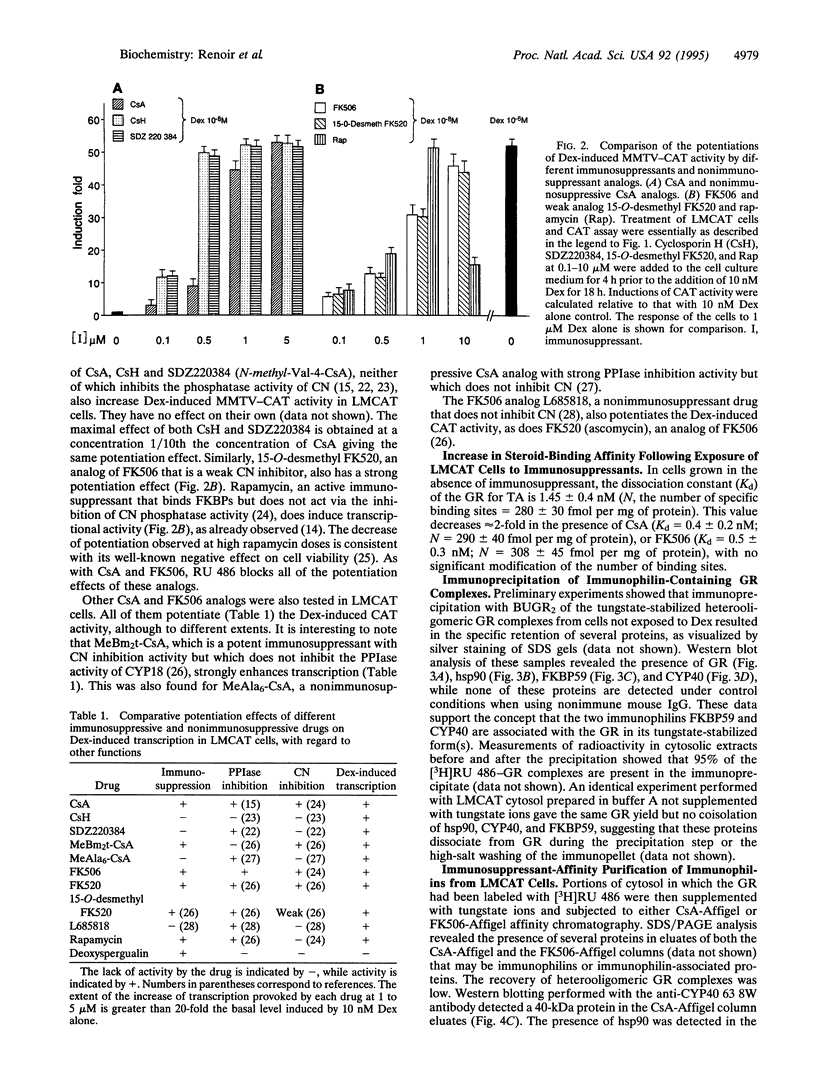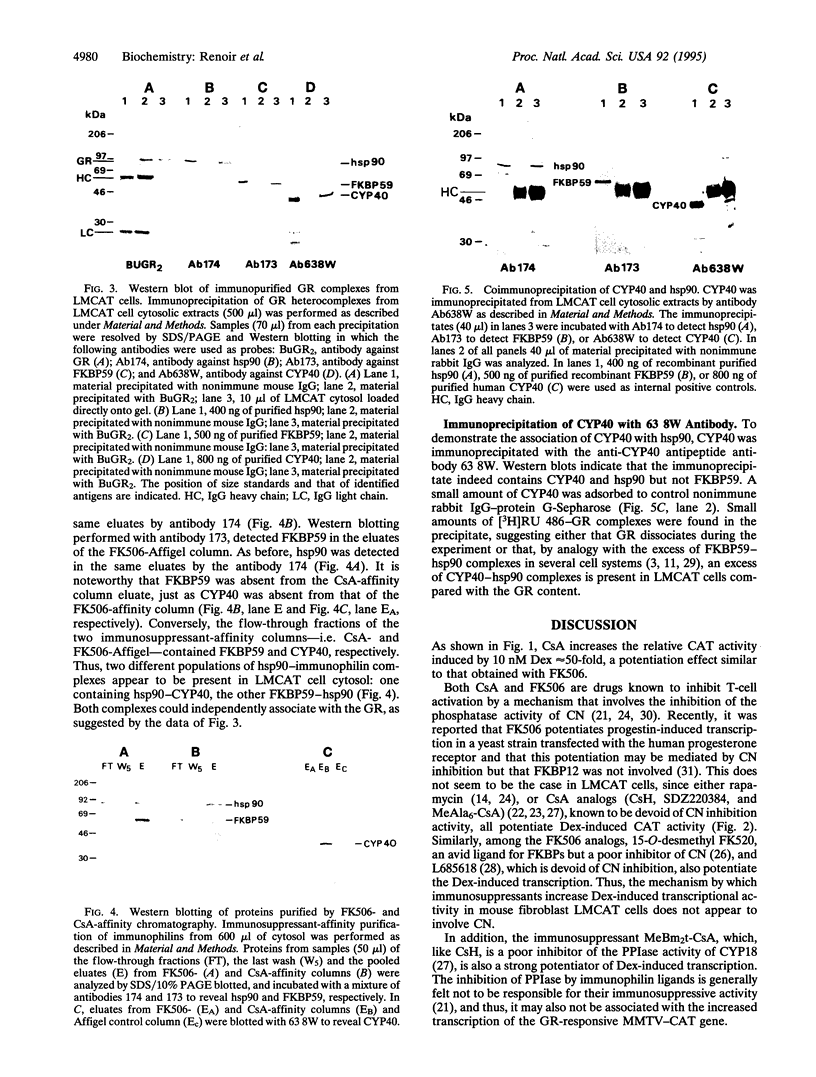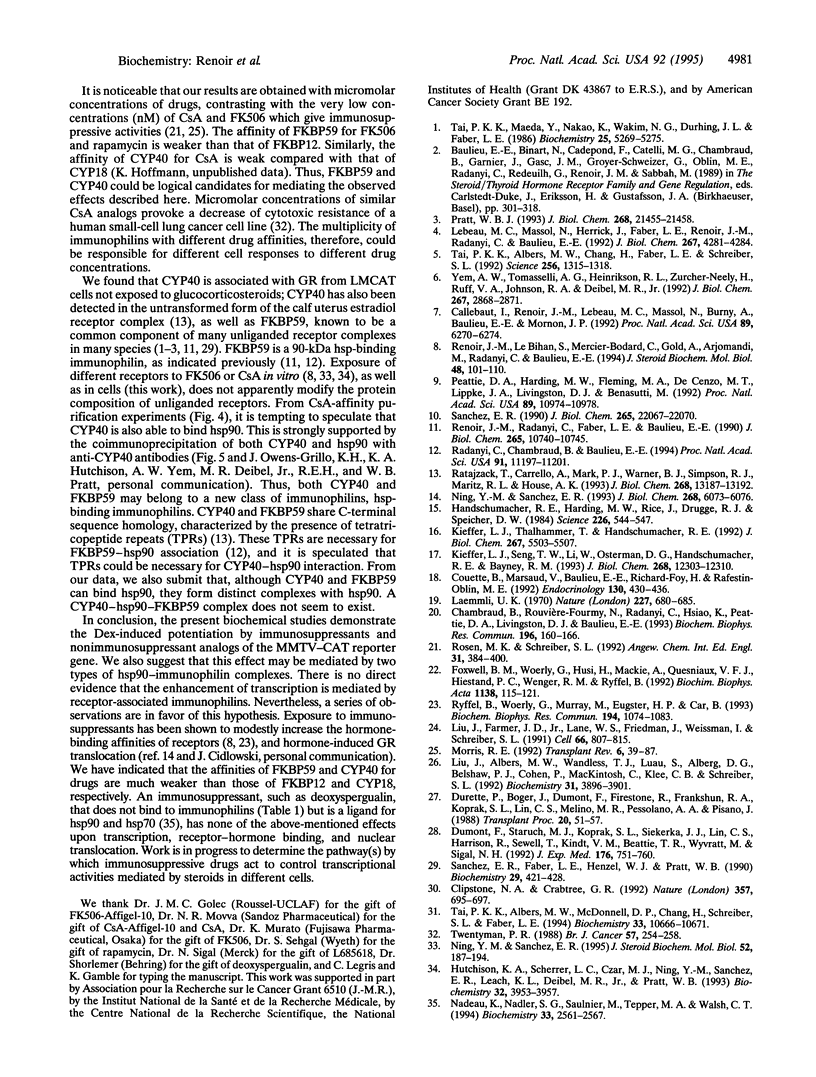Abstract
As previously observed for FK506, we report here that cyclosporin A (CsA) treatment of mouse fibroblast cells stably transfected with the mouse mammary tumor virus-chloramphenicol acetyltransferase (MMTV-CAT) reporter plasmid (LMCAT cells) results in potentiation of dexamethasone (Dex)-induced CAT gene expression. Potentiation by CsA is observed in cells treated with 10-100 nM Dex but not in cells treated with 1 microM Dex, a concentration of hormone which results in maximum CAT activity. At 10 nM Dex, 1-5 microM CsA provokes an approximately 50-fold increase in CAT gene transcription, compared with transcription induced by Dex alone. No induction of CAT gene expression is observed in cells treated with CsA or FK506 in the absence of Dex. The antisteroid RU 486 abolishes effects obtained in the presence of Dex. Using a series of CsA, as well as FK506, analogs, including some devoid of calcineurin phosphatase inhibition activity, we conclude that the potentiation effects of these drugs on Dex-induced CAT gene expression in LMCAT cells do not occur through a calcineurin-mediated pathway. Western-blotting experiments following immunoprecipitation of glucocorticosteroid receptor (GR) complexes resulted in coprecipitation of GR, heat shock protein hsp90 and two immunophilins: the FK506-binding protein FKBP59 and the CsA-binding protein cyclophilin 40 (CYP40). Two separate immunophilin-hsp90 complexes are present in LMCAT cells: one containing CYP40-hsp90, the other FKBP59-hsp90. Thus, both FKBP59 and CYP40 can be classified as hsp-binding immunophilins, and their possible involvement as targets of immunosuppressants potentiating the GR-mediated transcriptional activity is discussed.
Full text
PDF




Images in this article
Selected References
These references are in PubMed. This may not be the complete list of references from this article.
- Callebaut I., Renoir J. M., Lebeau M. C., Massol N., Burny A., Baulieu E. E., Mornon J. P. An immunophilin that binds M(r) 90,000 heat shock protein: main structural features of a mammalian p59 protein. Proc Natl Acad Sci U S A. 1992 Jul 15;89(14):6270–6274. doi: 10.1073/pnas.89.14.6270. [DOI] [PMC free article] [PubMed] [Google Scholar]
- Chambraud B., Rouvière-Fourmy N., Radanyi C., Hsiao K., Peattie D. A., Livingston D. J., Baulieu E. E. Overexpression of p59-HBI (FKBP59), full length and domains, and characterization of PPlase activity. Biochem Biophys Res Commun. 1993 Oct 15;196(1):160–166. doi: 10.1006/bbrc.1993.2229. [DOI] [PubMed] [Google Scholar]
- Chang M. C., Callahan P. M., Parkes-Loach P. S., Cotton T. M., Loach P. A. Spectroscopic characterization of the light-harvesting complex of Rhodospirillum rubrum and its structural subunit. Biochemistry. 1990 Jan 16;29(2):421–429. doi: 10.1021/bi00454a017. [DOI] [PubMed] [Google Scholar]
- Clipstone N. A., Crabtree G. R. Identification of calcineurin as a key signalling enzyme in T-lymphocyte activation. Nature. 1992 Jun 25;357(6380):695–697. doi: 10.1038/357695a0. [DOI] [PubMed] [Google Scholar]
- Couette B., Marsaud V., Baulieu E. E., Richard-Foy H., Rafestin-Oblin M. E. Spironolactone, an aldosterone antagonist, acts as an antiglucocorticosteroid on the mouse mammary tumor virus promoter. Endocrinology. 1992 Jan;130(1):430–436. doi: 10.1210/endo.130.1.1309341. [DOI] [PubMed] [Google Scholar]
- Dumont F. J., Staruch M. J., Koprak S. L., Siekierka J. J., Lin C. S., Harrison R., Sewell T., Kindt V. M., Beattie T. R., Wyvratt M. The immunosuppressive and toxic effects of FK-506 are mechanistically related: pharmacology of a novel antagonist of FK-506 and rapamycin. J Exp Med. 1992 Sep 1;176(3):751–760. doi: 10.1084/jem.176.3.751. [DOI] [PMC free article] [PubMed] [Google Scholar]
- Durette P. L., Boger J., Dumont F., Firestone R., Frankshun R. A., Koprak S. L., Lin C. S., Melino M. R., Pessolano A. A., Pisano J. A study of the correlation between cyclophilin binding and in vitro immunosuppressive activity of cyclosporine A and analogues. Transplant Proc. 1988 Apr;20(2 Suppl 2):51–57. [PubMed] [Google Scholar]
- Foxwell B. M., Woerly G., Husi H., Mackie A., Quesniaux V. F., Hiestand P. C., Wenger R. M., Ryffel B. Identification of several cyclosporine binding proteins in lymphoid and non-lymphoid cells in vivo. Biochim Biophys Acta. 1992 Feb 14;1138(2):115–121. doi: 10.1016/0925-4439(92)90050-w. [DOI] [PubMed] [Google Scholar]
- Handschumacher R. E., Harding M. W., Rice J., Drugge R. J., Speicher D. W. Cyclophilin: a specific cytosolic binding protein for cyclosporin A. Science. 1984 Nov 2;226(4674):544–547. doi: 10.1126/science.6238408. [DOI] [PubMed] [Google Scholar]
- Hutchison K. A., Scherrer L. C., Czar M. J., Ning Y., Sanchez E. R., Leach K. L., Deibel M. R., Jr, Pratt W. B. FK506 binding to the 56-kilodalton immunophilin (Hsp56) in the glucocorticoid receptor heterocomplex has no effect on receptor folding or function. Biochemistry. 1993 Apr 20;32(15):3953–3957. doi: 10.1021/bi00066a015. [DOI] [PubMed] [Google Scholar]
- Kieffer L. J., Seng T. W., Li W., Osterman D. G., Handschumacher R. E., Bayney R. M. Cyclophilin-40, a protein with homology to the P59 component of the steroid receptor complex. Cloning of the cDNA and further characterization. J Biol Chem. 1993 Jun 15;268(17):12303–12310. [PubMed] [Google Scholar]
- Kieffer L. J., Thalhammer T., Handschumacher R. E. Isolation and characterization of a 40-kDa cyclophilin-related protein. J Biol Chem. 1992 Mar 15;267(8):5503–5507. [PubMed] [Google Scholar]
- Laemmli U. K. Cleavage of structural proteins during the assembly of the head of bacteriophage T4. Nature. 1970 Aug 15;227(5259):680–685. doi: 10.1038/227680a0. [DOI] [PubMed] [Google Scholar]
- Lebeau M. C., Massol N., Herrick J., Faber L. E., Renoir J. M., Radanyi C., Baulieu E. E. P59, an hsp 90-binding protein. Cloning and sequencing of its cDNA and preparation of a peptide-directed polyclonal antibody. J Biol Chem. 1992 Mar 5;267(7):4281–4284. [PubMed] [Google Scholar]
- Liu J., Albers M. W., Wandless T. J., Luan S., Alberg D. G., Belshaw P. J., Cohen P., MacKintosh C., Klee C. B., Schreiber S. L. Inhibition of T cell signaling by immunophilin-ligand complexes correlates with loss of calcineurin phosphatase activity. Biochemistry. 1992 Apr 28;31(16):3896–3901. doi: 10.1021/bi00131a002. [DOI] [PubMed] [Google Scholar]
- Liu J., Farmer J. D., Jr, Lane W. S., Friedman J., Weissman I., Schreiber S. L. Calcineurin is a common target of cyclophilin-cyclosporin A and FKBP-FK506 complexes. Cell. 1991 Aug 23;66(4):807–815. doi: 10.1016/0092-8674(91)90124-h. [DOI] [PubMed] [Google Scholar]
- Nadeau K., Nadler S. G., Saulnier M., Tepper M. A., Walsh C. T. Quantitation of the interaction of the immunosuppressant deoxyspergualin and analogs with Hsc70 and Hsp90. Biochemistry. 1994 Mar 8;33(9):2561–2567. doi: 10.1021/bi00175a027. [DOI] [PubMed] [Google Scholar]
- Ning Y. M., Sanchez E. R. Stabilization in vitro of the untransformed glucocorticoid receptor complex of S49 lymphocytes by the immunophilin ligand FK506. J Steroid Biochem Mol Biol. 1995 Feb;52(2):187–194. doi: 10.1016/0960-0760(94)00162-f. [DOI] [PubMed] [Google Scholar]
- Ning Y. M., Sánchez E. R. Potentiation of glucocorticoid receptor-mediated gene expression by the immunophilin ligands FK506 and rapamycin. J Biol Chem. 1993 Mar 25;268(9):6073–6076. [PubMed] [Google Scholar]
- Peattie D. A., Harding M. W., Fleming M. A., DeCenzo M. T., Lippke J. A., Livingston D. J., Benasutti M. Expression and characterization of human FKBP52, an immunophilin that associates with the 90-kDa heat shock protein and is a component of steroid receptor complexes. Proc Natl Acad Sci U S A. 1992 Nov 15;89(22):10974–10978. doi: 10.1073/pnas.89.22.10974. [DOI] [PMC free article] [PubMed] [Google Scholar]
- Pratt W. B. The role of heat shock proteins in regulating the function, folding, and trafficking of the glucocorticoid receptor. J Biol Chem. 1993 Oct 15;268(29):21455–21458. [PubMed] [Google Scholar]
- Radanyi C., Chambraud B., Baulieu E. E. The ability of the immunophilin FKBP59-HBI to interact with the 90-kDa heat shock protein is encoded by its tetratricopeptide repeat domain. Proc Natl Acad Sci U S A. 1994 Nov 8;91(23):11197–11201. doi: 10.1073/pnas.91.23.11197. [DOI] [PMC free article] [PubMed] [Google Scholar]
- Ratajczak T., Carrello A., Mark P. J., Warner B. J., Simpson R. J., Moritz R. L., House A. K. The cyclophilin component of the unactivated estrogen receptor contains a tetratricopeptide repeat domain and shares identity with p59 (FKBP59). J Biol Chem. 1993 Jun 25;268(18):13187–13192. [PubMed] [Google Scholar]
- Renoir J. M., Le Bihan S., Mercier-Bodard C., Gold A., Arjomandi M., Radanyi C., Baulieu E. E. Effects of immunosuppressants FK506 and rapamycin on the heterooligomeric form of the progesterone receptor. J Steroid Biochem Mol Biol. 1994 Jan;48(1):101–110. doi: 10.1016/0960-0760(94)90256-9. [DOI] [PubMed] [Google Scholar]
- Renoir J. M., Radanyi C., Faber L. E., Baulieu E. E. The non-DNA-binding heterooligomeric form of mammalian steroid hormone receptors contains a hsp90-bound 59-kilodalton protein. J Biol Chem. 1990 Jun 25;265(18):10740–10745. [PubMed] [Google Scholar]
- Ryffel B., Woerly G., Murray M., Eugster H. P., Car B. Binding of active cyclosporins to cyclophilin A and B, complex formation with calcineurin A. Biochem Biophys Res Commun. 1993 Aug 16;194(3):1074–1083. doi: 10.1006/bbrc.1993.1931. [DOI] [PubMed] [Google Scholar]
- Sanchez E. R. Hsp56: a novel heat shock protein associated with untransformed steroid receptor complexes. J Biol Chem. 1990 Dec 25;265(36):22067–22070. [PubMed] [Google Scholar]
- Tai P. K., Albers M. W., Chang H., Faber L. E., Schreiber S. L. Association of a 59-kilodalton immunophilin with the glucocorticoid receptor complex. Science. 1992 May 29;256(5061):1315–1318. doi: 10.1126/science.1376003. [DOI] [PubMed] [Google Scholar]
- Tai P. K., Albers M. W., McDonnell D. P., Chang H., Schreiber S. L., Faber L. E. Potentiation of progesterone receptor-mediated transcription by the immunosuppressant FK506. Biochemistry. 1994 Sep 6;33(35):10666–10671. doi: 10.1021/bi00201a014. [DOI] [PubMed] [Google Scholar]
- Tai P. K., Maeda Y., Nakao K., Wakim N. G., Duhring J. L., Faber L. E. A 59-kilodalton protein associated with progestin, estrogen, androgen, and glucocorticoid receptors. Biochemistry. 1986 Sep 9;25(18):5269–5275. doi: 10.1021/bi00366a043. [DOI] [PubMed] [Google Scholar]
- Twentyman P. R. Modification of cytotoxic drug resistance by non-immuno-suppressive cyclosporins. Br J Cancer. 1988 Mar;57(3):254–258. doi: 10.1038/bjc.1988.55. [DOI] [PMC free article] [PubMed] [Google Scholar]
- Yem A. W., Tomasselli A. G., Heinrikson R. L., Zurcher-Neely H., Ruff V. A., Johnson R. A., Deibel M. R., Jr The Hsp56 component of steroid receptor complexes binds to immobilized FK506 and shows homology to FKBP-12 and FKBP-13. J Biol Chem. 1992 Feb 15;267(5):2868–2871. [PubMed] [Google Scholar]





